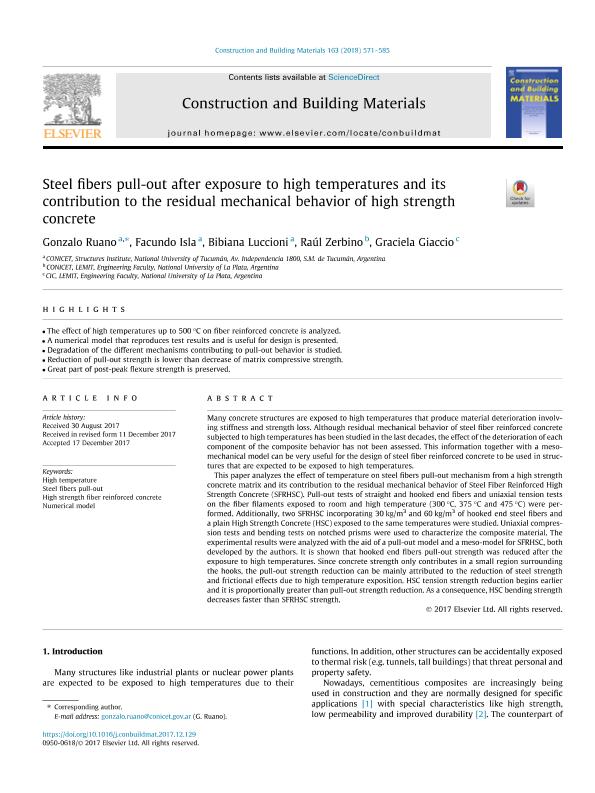Artículo
Steel fibers pull-out after exposure to high temperatures and its contribution to the residual mechanical behavior of high strength concrete
Ruano Sandoval, Gonzalo Javier ; Isla Calderón, Facundo Andrés
; Isla Calderón, Facundo Andrés ; Luccioni, Bibiana Maria
; Luccioni, Bibiana Maria ; Zerbino, Raul Luis
; Zerbino, Raul Luis ; Giaccio, Graciela Marta
; Giaccio, Graciela Marta
 ; Isla Calderón, Facundo Andrés
; Isla Calderón, Facundo Andrés ; Luccioni, Bibiana Maria
; Luccioni, Bibiana Maria ; Zerbino, Raul Luis
; Zerbino, Raul Luis ; Giaccio, Graciela Marta
; Giaccio, Graciela Marta
Fecha de publicación:
02/2018
Editorial:
Elsevier
Revista:
Construction And Building Materials
ISSN:
0950-0618
Idioma:
Inglés
Tipo de recurso:
Artículo publicado
Clasificación temática:
Resumen
Many concrete structures are exposed to high temperatures that produce material deterioration involving stiffness and strength loss. Although residual mechanical behavior of steel fiber reinforced concrete subjected to high temperatures has been studied in the last decades, the effect of the deterioration of each component of the composite behavior has not been assessed. This information together with a meso-mechanical model can be very useful for the design of steel fiber reinforced concrete to be used in structures that are expected to be exposed to high temperatures. This paper analyzes the effect of temperature on steel fibers pull-out mechanism from a high strength concrete matrix and its contribution to the residual mechanical behavior of Steel Fiber Reinforced High Strength Concrete (SFRHSC). Pull-out tests of straight and hooked end fibers and uniaxial tension tests on the fiber filaments exposed to room and high temperature (300 °C, 375 °C and 475 °C) were performed. Additionally, two SFRHSC incorporating 30 kg/m3 and 60 kg/m3 of hooked end steel fibers and a plain High Strength Concrete (HSC) exposed to the same temperatures were studied. Uniaxial compression tests and bending tests on notched prisms were used to characterize the composite material. The experimental results were analyzed with the aid of a pull-out model and a meso-model for SFRHSC, both developed by the authors. It is shown that hooked end fibers pull-out strength was reduced after the exposure to high temperatures. Since concrete strength only contributes in a small region surrounding the hooks, the pull-out strength reduction can be mainly attributed to the reduction of steel strength and frictional effects due to high temperature exposition. HSC tension strength reduction begins earlier and it is proportionally greater than pull-out strength reduction. As a consequence, HSC bending strength decreases faster than SFRHSC strength.
Archivos asociados
Licencia
Identificadores
Colecciones
Articulos(CCT - LA PLATA)
Articulos de CTRO.CIENTIFICO TECNOL.CONICET - LA PLATA
Articulos de CTRO.CIENTIFICO TECNOL.CONICET - LA PLATA
Citación
Ruano Sandoval, Gonzalo Javier; Isla Calderón, Facundo Andrés; Luccioni, Bibiana Maria; Zerbino, Raul Luis; Giaccio, Graciela Marta; Steel fibers pull-out after exposure to high temperatures and its contribution to the residual mechanical behavior of high strength concrete; Elsevier; Construction And Building Materials; 163; 2-2018; 571-585
Compartir
Altmétricas



